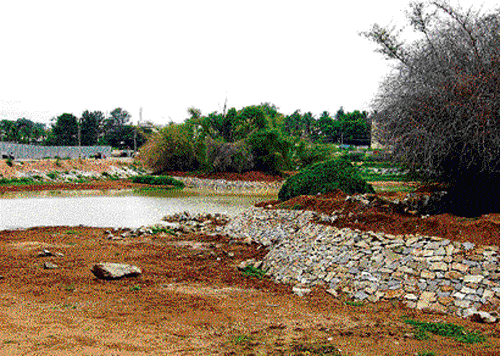
Heavy rain which lashed Bangalore for the last two days may have been a welcome development for a City reeling under a severe water crisis for the last two years, but they proved inadequate to fill a majority of lakes here.
On Sunday alone, the City received rainfall ranging between 42 mm and 55 mm, wreaking havoc in low-lying areas, where water gushed into the houses, destroyed property and made life difficult for residents.
This development, however, was in stark contrast to the areas of Uttarahalli Lake and Halagevaderahalli, lake near Rajarajeshwari Nagar, which look as parched as they did during summer, diminishing Bangalore’s reputation as a thriving City of lakes.
Once renowned for its 1,000 tanks and lakes, the City currently can lay claim to just 205 lakes. Of these, 55 are with Bruhat Bangalore Mahanagara Palike (BBMP), 123 are with the Bangalore Development Authority (BDA), four with the Lake Development Authority (LDA), five with the Karnataka Forest department and 18 lakes under the Minor Irrigation department. Barring several prominent lakes such as Sankey Tank, Hebbal Lake, Vengaiayana Kere, none have received water in monsoon. As many as 90 per cent of Bangalore’s lakes have failed to get water, sources said.
Sarakki Lake remains a cesspool of sewage, while Kacharakanahalli Lake near Hebbal continues to remain a playground. Another water body, Kengeri Lake, has become completely choked with weeds and remains a breeding ground for mosquitoes.
Man-made problem
According to Nivedita Sunkad, a resident of Halagevaderahalli, who has been fighting to protect and develop the Halagevaderahalli Lake, the water body has not received even 25 per cent of rainwater this year.
“There is a stormwater drain adjacent to the lake, but sewage flows right into it,” she said. “The BBMP had planned to connect the stormwater drain to the lake, but it is of no use unless the sewage is diverted from it.” Requesting anonymity, an officer in the Lake Development Authority blamed encroachment of stor water drains and catchment areas for the problem.
“Unless the stormwater drains and catchment areas are protected, none of the lakes in the City will receive water,” he said. He added that the water quality of the four lakes in the LDA’s custody — Hebbal, Agaram, Nagavara and Vengaiana Kere — is questionable as the water is not potable.
“Sewage continues to flow into these lakes,” he said. The view was echoed by a senior BBMP engineer in the Lake division, who also blamed the encroachment of stormwater drains and their catchment areas.
Govt mismanagement
Leo Saldanha of Environment Support Group accused the Bangalore Water Supply and Sewerage Board (BWSSB) of allowing the canals (Raja Kaluves) to become carriers of sewage.
According to Saldanha, the natural watershed has been extensively destroyed over an area of about 1,300 sq km for which BDA, NICE and the Karnataka Industrial Areas Development Board (KIADB) are equally responsible.